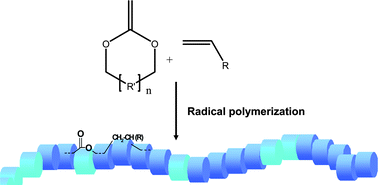Chemistry, chances and limitations of the radical ring-opening polymerization of cyclic keteneacetals for the synthesis of degradable polyesters
Abstract
This article highlights the progress in the field of radical

* Corresponding authors
a
Philipps-Universität Marburg, Fachbereich Chemie, Hans-Meerwein Strasse, Marburg, Germany
E-mail:
seema@chemie.uni-marburg.de
Fax: +00 49 6421 2825785
Tel: +00 49 6421 2825755
This article highlights the progress in the field of radical

 Please wait while we load your content...
Something went wrong. Try again?
Please wait while we load your content...
Something went wrong. Try again?
S. Agarwal, Polym. Chem., 2010, 1, 953 DOI: 10.1039/C0PY00040J
To request permission to reproduce material from this article, please go to the Copyright Clearance Center request page.
If you are an author contributing to an RSC publication, you do not need to request permission provided correct acknowledgement is given.
If you are the author of this article, you do not need to request permission to reproduce figures and diagrams provided correct acknowledgement is given. If you want to reproduce the whole article in a third-party publication (excluding your thesis/dissertation for which permission is not required) please go to the Copyright Clearance Center request page.
Read more about how to correctly acknowledge RSC content.
 Fetching data from CrossRef.
Fetching data from CrossRef.
This may take some time to load.
Loading related content
